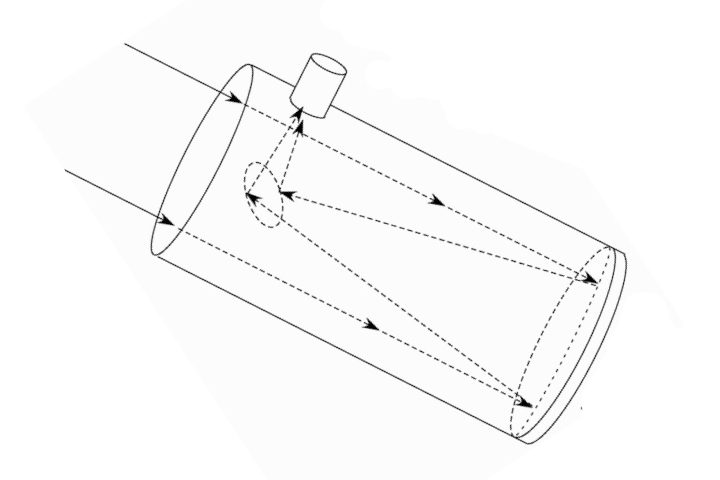Mirror Image: Reflection and Refraction of Light

When people look into a mirror, they see an image of themselves behind the glass. That image results from light rays encountering the shiny surface and bouncing back, or reflecting, providing a "mirror image." People commonly think of the reflection as being reversed left to right; however, this is a misconception. If you face north and look straight into a mirror, the east side of your face is still on the east side of the image, and the same is true for the west side. The mirror does not reverse the image left to right; it reverses it front to back. For example, if you are facing north, your reflection is facing south.
The reflection of light rays is one of the major aspects of geometric optics; the other is refraction, or the bending of light rays. Geometric optics is one of two broad classes of optics, the field that "deals with the propagation of light through transparent media," according to Richard Fitzpatrick, a professor of physics at the University of Texas at Austin, in lecture notes for a course in Electromagnetism and Optics. (The other class is physical optics.)
Geometric optics
Geometric optics treats light as continuous rays (as opposed to waves or particles) that move through transparent media according to three laws. The first law states that light rays move through similar transparent media in straight lines. The second states that when a light ray encounters a smooth, shiny (or conducting) surface, such as a mirror, the ray bounces off that surface. The third law governs how light rays behave when they pass between two different media, such as air and water. For example, when you look at a spoon in a glass of water, the submerged part of the spoon appears to be in a different place than expected. This happens because the light rays change direction when they go from one transparent material (air) into another (water).
Sir Isaac Newton laid down the foundation for geometrical optics in his classic 1704 work "Opticks." The principles he described are still used to this day to design eyeglasses, telescopes, microscopes, eyeglasses and camera lenses.

Reflection
Reflections from flat surfaces are fairly easy to understand. A reflection appears to be the same distance from the "other side" of the mirror as the viewer's eyes are from the mirror. Also, when light is reflected from a mirror, it bounces off at the same angle in the opposite direction from which it hit. For example, if the light hits a flat or "plane mirror" at a 30-degree angle from the left, it will bounce off at a 30-degree angle to the right.
However, if the surface of the mirror is curved, the angles of reflection are different at different points on the surface. The most common curved surface used in optical devices is a spherical mirror. If the mirror is convex, or curved outward, it will reflect a wider area, in which images appear smaller and farther away than those from a flat mirror. These mirrors are often used for outside rearview mirrors on cars and for keeping large areas under surveillance in stores.
If the surface is concave, or curved inward, a group of light rays from a distant source is reflected back toward a single location known as the focal point. This generally produces a magnifying effect, such as that seen in a makeup mirror. The radius of curvature of a mirror determines its magnification factor and its focal length.
Newton used a concave spherical mirror to make his reflecting telescope, a design that is still popular with amateur astronomers due to its simplicity, low cost and high degree of image quality.
In a Newtonian reflecting telescope, light rays from distant objects, which are essentially parallel (because they come from so far away), strike the concave main mirror at the same angle. The rays are then reflected back up through the telescope tube toward the focal point. However, before they reach the focal point, they strike a secondary, flat mirror that is tilted at a 45-degree angle. The secondary mirror diverts the light out through a hole in the side of the tube. The eyepiece lens then focuses the light. This produces a magnified image. Also, the image appears much brighter than it does to the naked eye because the mirror gathers and concentrates the light.
The shape of a spherical mirror affects the image that is reflected. Light striking near the edge of the mirror does not focus at the exact same spot as light striking nearer to the center. This results in what is called spherical aberration. This phenomenon is often corrected by using a combination of lenses, or in the case of large telescopes, by using parabolic mirrors, which are shaped like rounded cones that focus all the light from a source to a single point.

Refraction
Refraction is the bending of light rays. Normally, light travels in a straight line, and changes direction and speed when it passes from one transparent medium to another, such as from air into glass.
In a vacuum, the speed of light, denoted as "c," is constant. However, when light encounters a transparent material, it slows down. The degree to which a material causes light to slow down is called that material's refractive index, denoted as "n." According to Physics.info, approximate values of n for common materials are:
- Vacuum = 1 (by definition)
- Air = 1.0003 (at standard temperature and pressure)
- Water = 1.33 (at 68 degrees Fahrenheit or 20 degrees Celsius)
- Soda-lime crown glass = 1.51
- Sapphire = 1.77
- 71-percent lead flint glass = 1.89
- Cubic zirconia = 2.17
- Diamond = 2.42
These numbers mean that the speed of light is 1.33 times slower in water and 2.42 times slower in diamond than in a vacuum.
When light passes from a region of lower n, such as air, through a surface into a region of higher n, such as glass, the light changes direction. This means its path is closer to perpendicular, or "normal," to the surface. When the light passes from a region of higher n to the region of lower n, it bends away from the "normal" direction. This is what causes the submerged part of a spoon in a glass of water to appear to bend when you put it in water.
Focus
In a lens with a curved surface, parallel rays bend at different angles depending on the angle of the surface where the rays enter the lens. Parallel rays entering a convex lens converge on a point on the other side of the lens. However, when parallel rays enter a concave lens, they diverge, or spread out, on the other side of the lens. They are said to have a "virtual focal point" at the spot where the diverging rays would meet if they were extended backward to the near side of the lens.
Lenses can also be formed with a cylindrical surface, either convex or concave, which will magnify or reduce, respectively, an image in only one direction. These lenses are often combined with a spherical shape to produce a toric or spherocylinder lens. Such a lens is shaped like the surface of an inner tube, i.e., it has more curvature in one direction than another.
This shape is commonly used in eyeglasses to correct for astigmatism, a condition that causes blurred vision due either to the irregular shape of the cornea, the clear front cover of the eye, or sometimes the curvature of the lens inside the eye, according to the American Optometric Association. If you hold a pair of these eyeglasses away from your face and look through one lens as you rotate it, the astigmatic lens will cause the image to change shape.
Geometric optics does not cover all areas of optics, however. Physical optics covers topics such as diffraction, polarization, interference and various types of scattering. Quantum optics addresses the behavior and property of photons, including spontaneous emission, stimulated emission (the principle behind lasers) and wave/particle duality.
Jim Lucas is a freelance writer and editor specializing in physics, astronomy and engineering. He is general manager of Lucas Technologies.
Additional resources
Electromagnetism and Optics: An Introductory Course (Richard Fitzpatrick, University of Texas at Austin)
Sign up for the Live Science daily newsletter now
Get the world’s most fascinating discoveries delivered straight to your inbox.











